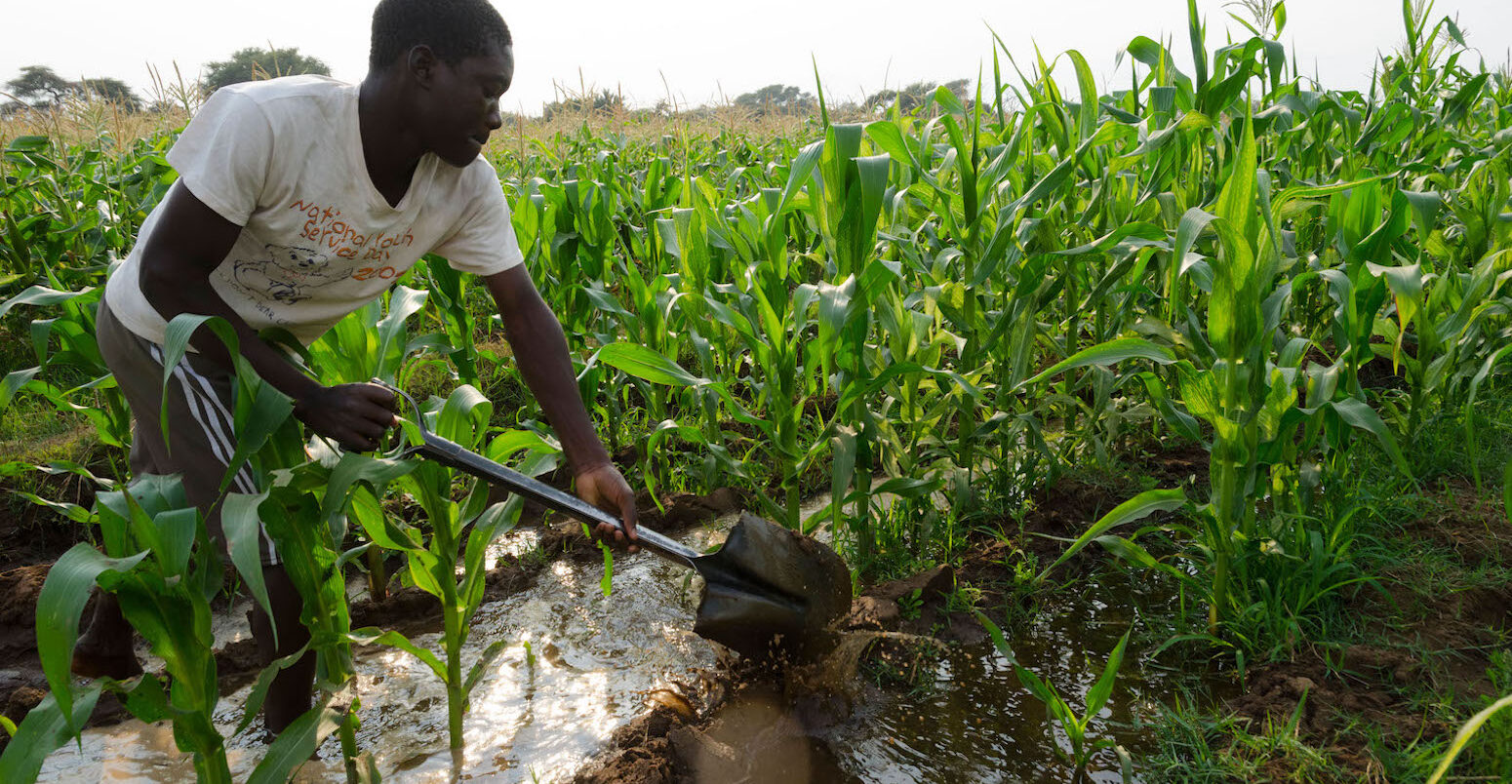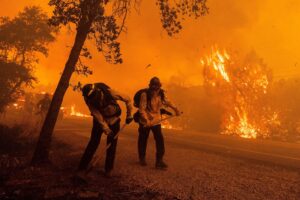
Guest post: How climate science is – and is not – shaping adaptation planning in southern Africa
Multiple Authors
05.01.25Multiple Authors
01.05.2025 | 4:45pmClimate science is a key tool for governments tasked with preparing citizens and infrastructure for the impacts of global warming.
But translating climate information into policy planning is no easy feat.
In a recent study, published in Climate Policy, we explore how climate science is – and is not – being used in national-level adaptation planning in 16 countries in southern Africa.
Based on analysis of UN documents, we find that there is often a disconnect between analysis of climate data, assessments of climate impacts and proposed adaptation options.
Adaptation plans also do not always consider the full range of plausible climate futures.
As well as identifying key barriers in how climate projections are being used, we offer some recommendations for how climate science could be more effectively integrated into adaptation plans, including enhancing collaboration between scientists and adaptation planners and clarifying what is meant by scientific uncertainty.
Climate adaptation
Climate adaptation can take place at many levels – from someone painting their roof white to keep their home cooler, for example, all the way up to the construction of large-scale flood defences.
Adaptation measures can include sustainable agricultural methods, including agroforestry; water collection and storage, such as dams; and public services, such as early warning systems and impact-based weather warnings.
Adaptation can be a response to current conditions, or a long-term plan based on projections of future climate change.
In many countries in southern Africa, governments face pressing economic challenges and deep structural inequalities, in addition to pronounced impacts from weather events. Long-term planning is not always at the top of priority list.
Yet, awareness of future climate might be crucial to avoid maladaptation – when adaptation interventions have negative consequences which increases vulnerability to climate change. (For example, a measure designed to increase irrigation to improve agricultural yields in a region projected to become drier, leading to increased water insecurity.)
National communications
To get a picture of how climate science is being factored into country-level adaptation planning, we analyse information in “national communications” submitted by countries to the UN, as well as conduct interviews with experts, government officials and climate scientists.
National communications are reports where countries provide updates on their vulnerability to climate change, as well as an inventory of their greenhouse gas emissions and the steps they are taking towards emissions reduction and adaptation.
Our study looks at national communications submitted by the 16 countries that form the Southern African Development Community (SADC). These are Angola, Botswana, Comoros, Democratic Republic of Congo, Lesotho, Madagascar, Malawi, Mauritius, Mozambique, Namibia, Seychelles, South Africa, Swaziland, Tanzania, Zambia and Zimbabwe.
Developing countries are required to submit national communications every four years to the UN Framework Convention on Climate Change (UNFCCC).
All southern African countries featured in the analysis have submitted at least one national communication. (Namibia and Zimbabwe have submitted five each.)
However, the UNFCCC’s guidance on how to assess climate impacts and vulnerability is very brief. It notes that countries “may use appropriate methodologies and guidelines they consider better able to reflect their national situation”.
The lack of specific guidance is perhaps not surprising, given that – currently – scientists do not have a common method for developing robust climate information to support decisionmaking. This has been recognised by the World Climate Research Programme, which has set up a working group that aims to establish what it means for a scientific product to be “robust”, or fit for informing local or regional decisionmaking.
In the absence of specific guidance, norms appear to have developed in the national communications.
Most of the national communications in southern Africa include a dedicated section on future projections from climate models. These tend to use global or regional climate models, such as CORDEX Africa.
The climate projections included in the national communications have a strong emphasis on long-term changes to temperature and rainfall.
The plot below demonstrates how temperature and rainfall projections are used in different ways in the 16 national communications in the analysis. For example, it shows that 13 reports include projections of annual precipitation variables, 10 feature projections for seasonal precipitation change and nine mention annual temperature projections.

However, we find that few countries chose to focus on other variables – such as heatwave or extreme rainfall indices – in the climate projections section of their national communications, despite these extremes often resulting in large impacts.
While there was an emphasis on flooding and drought in many reports, this was typically found in the impacts and adaptation section, which was often disconnected from analysis of climate projections.
All 16 national communications cited floods as a “top five hazard” and 13 included drought. However, in sections on climate projections, the reports rarely included analyses beyond average temperature and rainfall. Just four national communications included projections of sea level rise, while projections for tropical storms, ocean temperature and flooding were featured in one each.
We also find the impacts and adaptation sections typically lean on impact modelling and experience from recent weather events, not climate projections analysis.
(Impact models are used to test how climatic changes might influence other systems, for example crops, water resources or human health. These impact models sometimes use climate projections as an input – but not always.)
In the national communications, we find that, in some instances, there was a clear link between the climate projections section and impacts assessment. However, this was not always the case.
Accounting for uncertainty
We also find that most national communications are not adequately accounting for uncertainty in climate projections.
Climate projections are generated by running climate models with hypothetical future scenarios. These scenarios take into account different socioeconomic pathways the world may take, with implications for the amount of greenhouse gases emitted and the amount of global warming.
Such is the complexity of the climate system and the many unknowns of how global society will develop in future, there is a wide range of uncertainty in the projections that models produce.
While temperature projections tend to be relatively consistent across different climate models, rainfall projections – especially in regions such as southern Africa – carry much greater uncertainty. For many countries, some models suggest it will be wetter in future, while other models suggest it will be drier.
However, we found this uncertainty was not always stated in national communications. For example, some national communications use only a single model, the average across a collection of models or a single emissions scenario – meaning the range of climate futures and risks countries could face is not always being considered.
To best support adaptation planning, climate projections should be combined with interpretation. When climate projection data are presented on their own, they only tell us what the models show. Interpretation is needed to help decisionmakers consider what this data can tell us about the real world.
(There is a good example from South Africa’s third national communication, which uses a relatively novel approach for representing uncertainty. It uses “narratives” to describe the different climate futures that are possible in each province, such as “hot and dry” or “warmer, wetter”.)
Overall, it is not clear if the climate science set out in national communications is being used when deciding on adaptation options – raising the question of what role future climate information is playing in the documents.
Barriers
Climate science is complex – communicating and interpreting findings, as well as uncertainties, can be challenging. Uncertain rainfall projections in southern Africa in particular is making decisionmaking difficult.
To understand the barriers to integrating climate projections into adaptation decisionmaking, we interviewed 18 experts. This included government decisionmakers and technical experts, as well as climate modellers and applied researchers tasked with translating science for government officials.
One impact modeller told us: “The [climate projection] results are not agreeing. So then the question is, which results do you adopt at national level?”
We find that end “users” of future climate information, such as governmental adaptation planners, are not always able to interpret complex or uncertain findings – and have trouble accessing spatially-detailed information they require.
In some sectors, such as water and infrastructure, users and decisionmakers are knowledgeable and accustomed with uncertain climate projections – but officials in sectors such as health are less familiar.
Meanwhile, the flow of information from climate scientist to decisionmaker is not always direct. Instead, experts in third-party organisations – such as applied researchers or impact modellers – play a role in passing on information.
These external experts – which we refer to in the study as “boundary agents” – can improve the translation and dissemination of information between scientists and decisionmakers. However, in some instances, information is lost.
Our analysis shows that climate projections can become increasingly more certain as they are passed along by boundary agents. As one experienced climate scientist who has helped develop numerous national documents to the UN explained:
“Sometimes you use words like: ‘This looks like [a] plausible [pathway], this is one of the likely [pathways] that this signal is going to look like’ … But even if you have tried to maintain that these are probabilistic statements…don’t be surprised when you go some pages down the line [to read]: ‘this region is likely to get warmer by 5C’. Then you get a statement that says, ‘according to the climate model, we’re going to experience 5C warmer temperatures in the future’.“
Lessons for the future
Our study analyses tips from experts on how climate science could be more effectively used in adaptation planning, based on real-world experience.
The measures highlighted by the experts include:
- Creating spaces for collaboration between scientists and adaptation decisionmakers.
- Inviting adaptation decisionmakers to be included in the development of scientific analyses, to boost their understanding of uncertainty and different climate variables. This could also help scientists better understand the information needs of adaptation decisionmakers.
- Explaining climate science jargon, including by avoiding abbreviations such as DJF (meteorological nomenclature for December, January and February) or SSP (for shared socioeconomic pathways).
- Clarifying what is meant when discussing uncertainty, given that climate scientists are likely to be discussing uncertainties in climate modelling while adaptation planners uncertainty in governance and finance.
- Ensuring that maps and figures designed to communicate uncertainty are intuitive to people outside the world of climate science.
Overall, our research shows that there are adaptation processes in southern Africa where future climate projections are being included. However, it raises questions about how far the implications of future climate change are being integrated and understood.
Work is needed to incorporate a broader range of climate projections into planning – in particular, variables related to extreme weather such as heatwaves and flooding, which lead to large impacts, such as heat-related deaths or destruction of crops.
The uncertainties in climate projections must also be better considered, communicated and understood. This challenge is not unique to southern Africa; scientists around the world have important work to do to figure out how to communicate “robust” future climate information to decisionmakers.
Enhanced collaboration between climate scientists and planners, improved communication approaches and effective use of “boundary” organisations can help remove some of the barriers to the effective use of climate science in national adaptation planning in southern Africa.
Craig, A. et al. (2025) How is climate science used to inform national-level adaptation planning in southern Africa?, Climate Policy, doi:10.1080/14693062.2025.2488988





